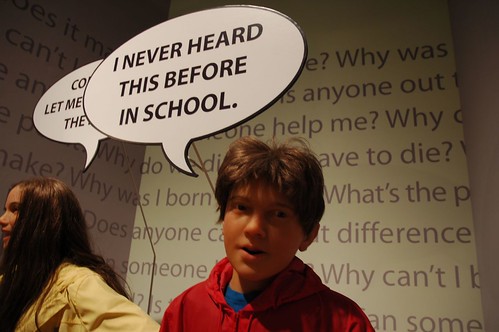If you look at the image on the left, you will notice the four key components of technology integration, what Collis & moonen (2002) refer to as key components of “flexible learning in a digital world”.
The components ( institution, implementation, pedagogy, and technology ) are nested in each other, which means that each depends on and feeds from the other. The approach for the flexible learning can be seen in a top-down, that institution-wide to technological aspect, or in a bottom-up, that is from the technological aspect all the way up to the institution.
The 4 E Model as a Guide:
Collis & Moonen suggest a 4 E model that will guide anyone who wants to integrate flexible learning in each and all key components
Ease of use
Environment
Personal Engagement
Educational Effectiveness
Now, I will not go into details of the activity-flexibility abstract framework and its U pedagogical approach. All I want to focus on here is how the 4 E model would guide the teachers in adopting/adapting and using technology in their teaching contexts, be it a complex, core technology such as a CMS ( content-management system) or a complementary technology tool such as PowerPoint, word processor, or a web2.0 tool .
E for Ease of Use:

The ease of use of the technology tool can be viewed from the teacher’s and student’s perspective . Is the teacher capable to use the tool with relative ease and exploit it for the students’ benefits? Is the student able to use the tool easily so as to focus on the intended task and not on the tool features?
Are the activities associated with the tool easy to accomplish? Will the students easily work through the activities supported by the tool ?
When a teacher decides to use this tool or that (X or Y) he/she should ask the question of : Is the tool easy to use? if not should there be an introductory activity to help students get the hang of it before using it for the subject or course?
E for Environment

Environment is a broad topic and it encompasses the educational institution or organization, the culture or socio-cultural aspect, and everything ( politics…) that affects holistically the adoption and adaption of the pedagogy and technology and the process of implementation.
Key questions such as : How does the educational institution, policy makers, or others in the position of power affect the implementation and use of technology and the associated pedagogy? Does the educational institution the teacher works in support the use of technology to enhance learning? or is he/she a pioneer?
In either case, the teacher who wishes to implement technology to enhance learning should not disregard the effect of the environment on the implementation process and should be keen on what is the best approach to use technology ( in-class access, home access, guided access, self-access…. )
E for personal Engagement

This E is tightly related to the teacher’s personal and professional engagement with the issue of technology in education and flexible learning as a whole. What drives some teachers to be engaged in technology to enhance learning? Is there any teaching beliefs behind that engagement? One should better gauge his or her beliefs on teaching with technology .
E for Educational Effectiveness

If a teacher decides to use a particular tool for learning and teaching, what is its educational effectiveness? The more the teacher sees that there is educational effectiveness, the more likely the teachers uses that tool . So, the underlying question here is: What is the pedagogical implication of this technological tool when exploited properly? How can technology enhance the learning process that was impossible or improbable before?
I believe that every teacher, administrator, or educational policy maker should be guided by the 4 E model not only in flexible learning but also in all technological pedagogies.
Now all you need to do is to select one tool that you used before with your students and compare it against the 4 E model. Do you think it was worth it using that tool ? Do you think it added anything worthwhile to the learning process and outcome?
Reference: Collis & Moonen (2002). Flexible Learning in a Digital World. Routledge
Professional Learning Networks for Teachers
2:12 PM
0 comments
Many language teachers are more and more comfortable with technology in their daily mundane life though most do not infuse their technology into the classroom context. This is probably due to the fear of taking risks and experimenting in the classroom. Those same teachers log on everyday online and socialize with friends and colleagues. But that’s just about it. With the increase use of web2.0 technology in all aspects of communications, educators around the world can link with each other to share beliefs, ideas, resources, and innovations in education.
In my teaching context teachers log online everyday, for hours, to socialize and check on other people’s news and updates. Social networking has been largely adopted, often with ease, by all educators, whether tech comfy/savvy or not ( e.g. Facebook , MySpace, Hi5, twitter , and others…). If a teacher logs online for educational purposes, he/she acts as a passive participant. Common behaviors include downloading resources such as worksheets, videos, etc…
From social networking software appeared the professional learning network. It is a network of educators who share knowledge together, sometimes in a collaborative mode. The teacher is now able to open up to the wider international educators to enrich his/her and benefit other teachers with this socio-cultural approach.
Professional/Personal Learning Networks
The best professional learning networks are usually social networking environments and micro blogging.
Social networking environments

To me Ning is at the top of the list here ( though others like Facebook has potentials). Ning is a social environment where like-minded people can share ideas and discuss on what interests them.
Classroom20 is one great PLN ( professional/personal learning network) where educators all around the globe join in for one reason “How to improve education, especially with the use of web2.0.”
The Arcal and Webhead Learning Hub is a network of teachers helping other teachers integrate ICT in their teaching. The eflclassroom is another edu ning network where ELTs collaborate and discuss issues that concerns them as English language teachers and educator. Eflclassoom is abundant with resources for the English teacher. However, that best resource is the discussion that goes on between teachers.
There are also special interest education networks like ning in education ( Best practices on using ning for educational purposes), Technology Integration in Education ( Sharing and discussing best ways on integrating technology in the classroom), The Future of Education ( charting the course of teaching an learning in a networked world)), learncentral ( asynchronous social networking and the ability to store, organize, and find educational resources with the live, online meeting and collaboration provided by Elluminate technology ), Games in Education ( use of electronic games in pedagogical context), and IATEFL learning technologies to name a few …
Microblogging : Twitter
 is considered by educators the best PLN as it enables educators to share resources and discuss issues in a 140 character message. When an educator first starts tweeting her/she does not fell the significance of
is considered by educators the best PLN as it enables educators to share resources and discuss issues in a 140 character message. When an educator first starts tweeting her/she does not fell the significance of I have seen educators who wanted to start tweeting but couldn’t find educators to follow
There are also discussions or chats that educators hold frequently like #edchat and #edtech where educators focus on one topic to explore.





